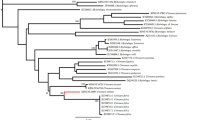Summary
-
1.
The olfactory organs of 30 teleost species of four cyprinodontoid families (Cyprinodontidae, Jenynsiidae, Anablepidae, Poeciliidae) are studied and the type most commonly found is described.
-
2.
The olfactory epithelium was found to be confined to the planar lower surface of the olfactory chamber and to contain sensory and indifferent epithelium. The sensory epithelium is separated into distinct areas by ridges of indifferent cells.
-
3.
These ridges grow in towards the center of the sensory epithelium from the sides of the olfactory chamber in a different way from that in which olfactory lamellae are formed. These ridges are similar to the formations found in the olfactory chamber in some fish species, but are not thought to be rudimentary lamellae.
-
4.
The planar surface of the olfactory epithelium is considered to be an adaptation to special morphological factors (flat head and olfactory chamber).
Zusammenfassung
-
1.
DasGeruchsorgan von 30 Teleosteerarten aus vier Familien der Zahnkarpfen (Cyprinodontidae, Jenynsiidae, Anablepidae und Poeciliidae) wird untersucht and der am häufigsten vertretene Bautyp beschrieben.
-
2.
Die auf einem flachen Riechhöhlenboden angeordnete Riechschleimhaut besteht aus Sinnesepithel, das durch hervortretende Leisten aus indifferentem Epithel in zahlreiehe Riechepithelfelder aufgeteilt ist.
-
3.
Diese Leisten entstehen nicht wie Riechfalten, sondern wachsen vom Rand der Riechschleimhaut nach innen und zerteilen das anfangs zusammenhängende Sinnesepithel. Sie ähneln Bildungen im Geruchsraum anderer Fishhe, sind aber nicht als Riechfaltenrudimente aufzufassen.
-
4.
Die flache Anordnung dieser Riechschleimhaut wird als eine speziellen morphologischen Verhältnissen (flache Schädelform und flashes Riechhöhlenlumen) angepaßte Auskleidung der Riechhöhle aufgefaßt.
Similar content being viewed by others
Literatur
Blaue, J.: Untersuchungen über den Ban der Nasenschleimhaut bei Fischen und Amphibien. Arch. Anat. Physiol. Anatomische Abteilung. 1884, 231–309 (1884).
Burne, R. H.: The anatomy of the olfactory organ of teleostean fishes. Proc. zool. Soc. Lond. 1909, 610–663 (1909).
Derscheid, I. M.: Contributions à la morphologie céphalique des Vertébrés. A.: Structure de l'organe olfactif chez les poissons. Annls Soc. r. zool. Belg. 54, 79–162 (1923).
Dogiel, A.: Über den Bau des Geruchsorganes bei Ganoiden, Knochenfischen und Amphibien. Arch. mikr. Anat. 29, 74–139 (1887).
Greenwood, P. H., Rosen, D. E., Weitzman, S. H., Myers, G. S.: Phyletic studies of teleostean fishes, with a provisional classification of living forms. Bull. Amer. Mus. Nat. Hist. 131, 339–456 (1966).
Holl, A.: Vergleichende morphologische und histologische Untersuchungen am Geruchsorgan der Knochenfische. Z. Morph. Okol. Tiere 54, 707–782 (1965).
Holl, A., Schulte, E., Meinel, M.: Funktionelle Morphologie des Geruchsorgans und Histologie der Kopfanhänge der Nasenmuräne Rhinomuraena ambonensis (Teleostei, Anguilliformes). Helgoländer wiss. Meeresunters. 21, 103–123 (1970).
Kamon, K.: Über die „Geruchsknospen”. Arch. mikr. Anat. 64, 653–664 (1904).
Kleerekoper, H.: Olfaction in fishes. Bloomington: Indiana University Press 1969.
Liermarm, K.: Über den Ban des Geruchsorgans der Teleostier. Z. Anat. Entwickl.Gesch. 100, 1–39 (1933).
Madrid-Moreno, J.: Über die morphologische Bedeutung der Endknospen in der Riechschleimhaut der Knochenfische. Biol. Zbl. 6, 589–592 (1887).
Parzefall, J., Wilkens, H.: Artbildung bei Höhlenfischen. Vergleichende Untersuchungen an zwei amerikanischen Synbranchidac (Pisces). Z. Morph. Tiere 73, 63–79 (1972).
Pfeiffer, W.: The morphology of the olfactory organ of the pacific salmon (Oncorhynchus). Canad. J. Zool. 41, 1233–1236 (1963).
Pfeiffer, W.: The morphology of the olfactory organ of Hoplopagrus guentheri Gill 1862. Canad. J. Zool. 42, 235–237 (1964).
Pfeiffer, W.: Das Geruchsorgan der Polypteridae (Pisces, Brachiopterygii). Z. Morph. Tiere 63, 75–110 (1968).
Pfeiffer, W.: Das Geruchsorgan der rezenten Actinistia und Dipnoi (Pisces). Z. Morph. Tiere 64, 309–337 (1969).
Pfeiffer, W.: Ban, Leistung und biologische Bedeutung des Geruchsorgans der Knochenfische. Naturw. Rdsch. 24, 417–423 (1971).
Reinke, W.: Zur Ontogenie und Anatomie des Geruchsorgans der Knochenfische. Z. Anat. Entwickl.-Gesch. 106, 600–624 (1937).
Retzius, M. G.: Zur Kenntnis der Nervenendigungen in der Riechschleimhaut. Biol. Unters., N. F. 4, 62–64 (1892).
Romeis, B.: Mikroskopische Technik, 15. Auflage. München: R. Oldenbourg 1948.
Rosen, D. E.: The relationships and taxonomic position of the halfbeaks, killifishes, silversides, and their relatives. Bull. Amer. Mus. Nat. Hist. 127, 217–268 (1964).
Rosen, D. E., Bailey, R. M.: The poeciliid fishes (Cyprinodontiformes), their structure, zoogeography, and systematics. Bull. Amer. Mus. Nat. Hist. 126, 1–176 (1963).
Schemmel, C.: Vergleichende Untersuchungen an den Hautsinnesorganen oberund unterirdisch lebender Astyanax-Formen. Z. Morph. Tiere 61, 255–316 (1967).
Sewertzoff, A. N.: Morphologische Gesetzmäßigkeiten der Evolution. Jena: Gustav Fischer 1931.
Stenholt Clausen, H.: Tropical old world cyprinodonts. Kobenhavn: Akademisk Forlag 1967.
Sterba, G.: Süßwasserfische aus aller Welt. Melsungen-Berlin-Basel-Wien: J. Neumann-Neudamm 1970.
Tavolga, W. N.: Embryonic development of the platyfish (Platypoecilus), the swordtail (Xiphophorus), and their hybrids. Bull. Amer. Mus. Nat. Hist. 94, 161–230 (1949).
Teichmann, H.: Vergleichende Untersuchungen an der Nase der Fische. Z. Morph. Okol. Tiere 43, 171–212 (1954).
Teichmann, H.: Die Chemorezeption der Fische. Ergebn. Biol. 25, 177–205 (1962).
Trujillo-Cenóz, O.: Electron microscope observations on chemo- and mechanoreceptor cells of fishes. Z. Zellforsch. 54, 654–676 (1961).
Author information
Authors and Affiliations
Rights and permissions
About this article
Cite this article
Zeiske, E. Morphologische untersuchungen am geruchsorgan von zahnkarpfen (Pisces, Cyprinodontoidea). Z. Morph. Tiere 74, 1–16 (1973). https://doi.org/10.1007/BF00291793
Received:
Issue Date:
DOI: https://doi.org/10.1007/BF00291793




